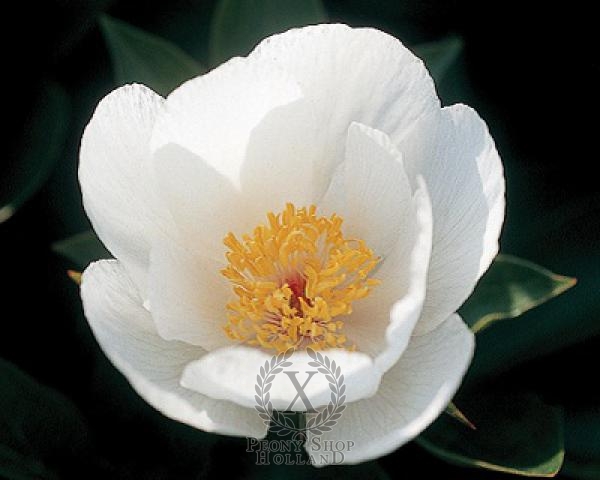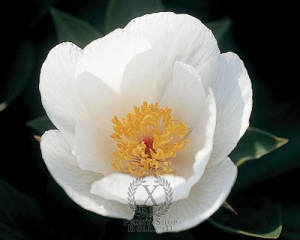Peony Squirt
| Size | Weight |
|---|---|
| 3/5 eye | 250 gram |
Peony Squirt is one of the many special dwarf single white Peonies that we grow at Peony Nursery Peony Shop Holland.
Rock Garden Peonies
Peony Squirt belongs to the Rock Garden Peonies These rock garden peonies are the shortest varieties we grow! Very charming, herbaceous perennials, our rock garden peonies have foliage, texture and blossoms sized in perfect proportion to their smaller stature. Rock-garden varieties are named for their short heights (generally below 21") and their adaptability for today's smaller landscapes and gardens.Peony Soil
Peonies love good drained rich organic nutritious soils. Over the years we have developed a tedious process for growing the highest quality of peonies possible. As our company is located in the northern part of the Netherlands, we are blessed and cursed with a heavy clay soil. On the one hand side this soil is perfect for peony growth and therefore nature helps us to grow the biggest, highest quality peonies fast. On the other hand the clay ground forces us to take extensive measures before storing or exporting the peony roots. For cut-flower production it doesn't matter, once planted they enjoy the rich nutritious clay soil and become to compare with sand soils,, not only stronger as plant in general, but also much faster into production and shown bigger size Peony heads!
Peony planting of Squirt
Peonies can be planted manually or mechanically. We have chosen to plant our Exclusive Peonies manually and the other Peonies by machine.
Before planting the peonies, the soil needs to be prepared well. This is a crucial element in the peony growing process. First the soil where the roots is grown needs to be properly flattened and drained in order to prevent potential water damage (from heavy rain).
After having cultivated the land properly (with a milling- or spade-machine) the roots are to be planted at a depth of 2 - 3 cm. This depth is very decisive because if the roots are planted too deep, the production of flowers will diminish or even completely vanish. The distance between the cuttings depends on the variety. Some varieties need more or less space than others. Furthermore, the time-period that roots will remain on a particular spot has to be taken into consideration as well.
Fertilizing and Weeding the Peonies
Peonies must be fertilized during the winter months. There is no rule to the amount of usage of each element (Nitrogen, Phosphorus, Potassium), because this depends on the nature of the soil. Peonies flourish best on soil with a pH from 6 to 7.
During the winter season chemicals against weeds can be used as well. It is important to do this during the cold season, because then the roots are at "rest" (dormant). Otherwise the roots are apt to absorb the chemicals which will cause damage to the peony.
When the young root starts growing in spring several kind of preventive fungicides can be used. This can be persisted until two weeks before harvesting.

Theo is about to 'feed' the peonies
Upcoming of the Peonies in Early Spring
When the first Peonies show up in February / March, the use of wind fences can be most helpful to protect the still vulnerable peony plants. The fences are usually placed from the east to west to keep the cold northern wind out.
No gates are placed from south to north because that allows the wind to keep the plants dry and prevent the spread of Botrytis. When the plants are still small and vulnerable to diseases, copper sulphate can be used to ensure a firm and healthy plant. Several fungicides can be used to protect the plants against Botrytis (preventive).
Mowing the Peonies
The mowing of peonies takes place at the end of August. It is very important that all dead organic material is removed because all kind of diseases lives in dead organic material.
This material can be gathered by a tractor with a sweeping tool attached or by hand with picking forks. The last remains must always be removed manually.
About Peony Farm "Peonyshop.com" Lutjebroek, the Netherlands
Peony Nursery Peony Shop Holland nowadays specifically centers on developing exclusive, outstanding high-quality peonies. It has not always been this situation. This company has got a wealthy background starting up in the year 1875 with Simon Scholten that was basically growing fruit and vegetables for her income.
In 2001 the firm put together their unique brand-new promotion-title & logo "Peonyshop.com" and after that they started off focusing on improving unique peonies. During 2002 the particular firm launched their very own online peonyshop with Peonies & Buxus. Within 2003 Joshua Scholten began with raising peonies. After that in year 2004 this company began to foreign trade peonies of the Netherlands all-around European countries, Usa and also Asia.
Nowadays our peony nursery is specialised in expanding and spreading unique, top quality peony roots that can be marketed and exported to internationally. In addition we additionally cut peonies mainly assisting the Dutch peony flower marketplace.
The things we pride:- The top quality of our own product
- The capability to foreign trade international
- The best substantial assortment peonies like Squirt
- The peony crame of high potential seedling peonies
About growing Squirt peony plants
Fall is without a doubt the perfect period of time if you think about planting peony plants. The peonies have proven to be unbelievably long-lived plants long lasting approximately 50 to 70 years, so as soon an individual get the peonies placed in the right way, a person will have fun with the peonies for years. These plants have a preference for some sort of shiny place having a well-drained dirt. A good quality air circulation available the plant can also be required. These sorts of circumstances allow this type of plants to stay away from illness problems. To organize a sowing hole for a bareroot peony plant, dig the dirt to the depth around 12-18inches. Work with garden tools to release the edges of the particular seeding hole as well. It's always especially important and vital that the "eye", or growth, nodes, located near the base of the old stem, end up no more than 2 " under the soil surface area.


